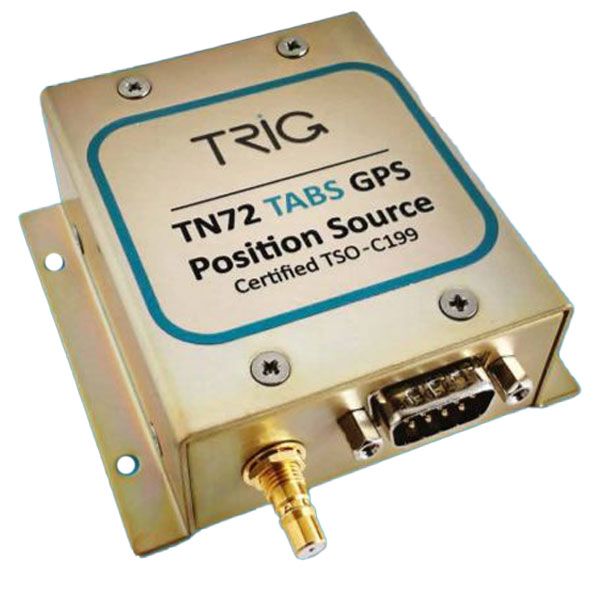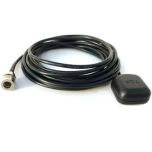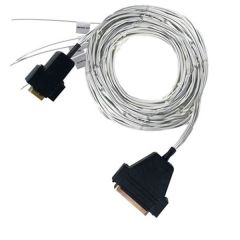Trig TN72 GPS Receiver
Manufacturer Part Number 01685-00-01
Trig TN72 GPS Receiver


General Description
Trig TN72 GPS Receiver - Sailplane pilots now have a dedicated ADS-B Out solution that’s tailor-made for voluntary equipage. Trig’s new TN72 TABS GPS is certified to TSO-C199, the FAA’s technical standard designed specifically for ADS-B Out equipage in sailplanes. Fitting a TN72 TABS GPS with a Trig transponder significantly improves your visibility and enhances safety.
A Trig TN72 TABS GPS works in combination with a Trig transponder, providing real-time airspace reporting and surveillance. Automatic Dependant Surveillance Broadcast (ADS-B) technology is built into every Trig transponder and meets FAA certification TSO-C166b.
Whilst ADS-B is optional for sailplanes, equipping is a smart move. Fitting a TN72 TABS GPS means your location is shared directly with other ADS-B In equipped aircraft. By 2020 the majority of GA and all commercial aircraft will be equipped. A modest investment today will make you visible to all - for your safety and the safety of others it makes sense to equip.
With a traffic receiver, you will be able to receive a real-time display of other aircraft in your vicinity. A TN72 TABS GPS and a Trig transponder will trigger a full ADS-B In traffic service from FAA ground stations to your ADS-B In device. You can fly with confidence as the TN72 TABS GPS is certified and visible to all ADS-B In equipped aircraft.
When fitting a TN72, it uses one of two available configuration options, in the transponder settings (see below). The TN72 hardware is the same in either installation, you may require a software update and you will need to install a TA50 or TA70 GPS antenna.
TN72 GPS – TABS C199 (Traffic Awareness Beacon System) this configuration uses SIL 1/ SDA 1 in the transponder settings. TABS is the FAA technical standard that enables voluntary equipage of ADS-B Out. The TN72 using TABS is ideal for ‘voluntary’ equipage in Europe or where ADS-B Out is not mandated.
W&W typically stocks Trig TN72 TABS GPS Position Source.
| Specification | TN72 GPS Receiver |
| Type | TABS (SBAS) |
| Certification | TSO-C199 Class B |
| Compliance | TSO-C199 Class B, DO-160G |
| Supply voltage (DC) | 11 – 33 V |
| Typical consumption (at 14v) | at 14V – 0.1A |
| Operating temperature | -40°C to + 70°C |
| Cooling requirement | no fan required |
| Weight | 110 grams / 3.8 ounces |
| Connector | GPS (power, ground and GPS data) – 9 way D type Antenna – 5V phantom power – QMA m |
| Dimensions (mm) | H 30 x L 90 x W 63mm (W with base flange 80mm) |
| Dimensions (inches) | H 1.2” x L 3.6” x W 2.5” (W with base flange 3.2”) |


ADS-B OUT
(1090ES ADS-B Out is the international standard and can be used worldwide)


ADS-B OUT AND ADS-B IN
This illustrates aircraft operating within a full ADS-B environment. Note that ground services are only available in the U.S. (these include weather and traffic services).


ADS-B uses a Trig transponder, typically combined with a GPS, to transmit highly accurate positional is information to ground controllers and also directly to other aircraft. This transmission is known as ADS-B Out and its accuracy is greater than using conventional radar surveillance. This gives air traffic controllers the potential to reduce the required separation distance between aircraft that are ADS-B equipped.
ADS-B is seen as being vital to maintaining future efficient airspace management in busy airspace. It also provides advantages in remote ‘non radar’ areas too – here suitably equipped aircraft, with a traffic receiver connected to a display can see other aircraft without conventional radar coverage. This enhances aircraft visibility and reduces the risk of air to air collision.
ADS-B uses satellite and transponder technology to provide the following benefits in an ADS-B environment:
More aircraft can operate safely in the same airspace, so congestion is reduced.
ADS-B technology enables more direct aircraft routing – this can generate significant time and fuel savings.
With appropriate equipment it’s possible to have a live ‘traffic picture’ in the cockpit.
ADS-B enhances flight safety and collision avoidance.
Aircraft with ADS-B Out provide air traffic controllers with ‘pin point’ positional and flight information data. Trig supports 1090ES, the ICAO international standard for ADS-B that can be used throughout the world.
- TN72 GPS Receiver
- All Trig products come with a two year warranty, starting from the day of installation
- EASA Form One
- Installation kit:
- TN72 Installation Manual (1) 01691-00
- Connector Co-axial QMA (1) 01697-00
- Headshell, 9 Way (1) 00725-00
- 9 way D-type contact housing (female) (1) 00727-00
- Crimp Terminal, Female, 22-24 AWG (9) 00730-00
Experimental Glider


Certified Glider


I fly in a certified aircraft in the US, can I use the TN72?
The TN72 can be used by light-sport, experimental aircraft and home-builts to meet FAR 91.227.
In you are in North America and you fly a Part 23 aircraft in ADS-B 2020 rule airspace then you will require full ADS-B compliance. You can use a TN70 GPS Receiver, which is TSO-C145 compliant. If you already have a GNS or GTN WAAS Navigator you can use this as a GPS position source with a suitable Class 1 Trig transponder (TT31 or TT22). If you only wish to fly outside 2020 rule airspace in a certified aircraft then a TN72 can be used.
Can the TN72 be used in Europe?
Yes - EASA and the UK CAA are keen to encourage pilots to equip with certified 1090 ADS-B Out equipment. The more pilots who equip with ADS-B Out the greater the opportunity to reduce air to air collisions and improve safety, using a common ICAO standard. Installation of the TN72 in EASA aircraft is simple using CS-STAN (see support pages).
Can the TN72 be used in Australia and New Zealand?
The TN72 can be used for ADS-B in Australia and New Zealand. Regulations in both countries have been subject to change and are best checked with the regulator for your aircraft type. In Australia see CASA advisory circular 91/23 in New Zealand see NZ CAA Notice of Requirement NTC91.258 and AC91-24 for further information.
Can the TN72 really help in collision avoidance?
Yes - The TN72 GPS was tested and evaluated as part of Project EVA, a European wide project EASA (SESAR) initiative to test ADS-B technology. Because the TN72 uses certified GPS technology it can be relied upon to provide dependable position reporting for collision avoidance. Unlike uncertified GPS units the TN72 will be visible to all ADS-B In equipped technology.
What are the key benefits of an aviation GPS source like the TN70 or TN72 compared to a consumer GPS receiver?
With good satellite coverage, both will give an accurate position fix – they use the same technology and the same GPS satellite sources. The big difference is how they behave when coverage is poor or lost. A consumer GPS will estimate a position and trajectory for some time after losing satellite data. That gives the user apparent continuity when driving under bridges, or walking past tall buildings, but that behaviour is not suitable for safety critical applications, especially in a dynamic 3D environment like an aircraft. An aviation GPS will perform fault detection and exclusion to remove poor satellite data from any position solution, and will report loss of position integrity or loss of position very quickly. That appears to users that the aviation GPS is “worse” than the consumer GPS, since it gives up reporting a position when the consumer GPS keeps running. That is a deliberate safety design decision.
Why does my certified GPS take longer to find a position fix than my uncertified handheld device when I switch them both on?
Once it has locked on to the satellite transmissions, any GPS receiver needs data on the position of the satellites – called ephemeris data – to calculate the receiver position. Each satellite transmits its own data every 30 seconds. It takes 18 seconds to send the ephemeris data and the other 12 seconds in the cycle contains data about the rest of the satellite constellation. Depending on where in the 30 second cycle the satellites were when the receiver was switched on, it could take between 18 and 30 seconds to acquire the ephemeris data. The downlinked data has parity bits for error detection, but does not support error correction or higher integrity checks. For a safety of life application like aviation, the solution is that a certified receiver must hear the same ephemeris data twice before it is allowed to use it. This means a minimum acquisition time for each satellite of 48 to 60 seconds. Total time will be longer than this taking into account system initialisation, interference, and other environmental factors, but a fix after a minute or so is normal. So how does an uncertified GPS beat that? The first speed gain is simple – consumer GPS doesn’t wait for the second copy of the ephemeris data, it simply believes what it was told the first time. As a result, it can have a position fix in between 18 and 30 seconds. But an even quicker solution is available to a GPS built into a phone or anything else with a data link – instead of waiting for the ephemeris data to be transmitted slowly from the satellite, it fetches the same data from an online server. With a good data connection like a 3G phone, it might take only 1 or 2 seconds to receive all the ephemeris data over the line, and then a GPS position can be determined in less than 5 seconds.
Can I use a small puck antenna with the TN72?
Our TA50 Compact GPS Antenna is made specifically for the TN72. It is ideal for installations where space is at a premium. It is usually mounted near the windscreen, with a good view of the horizon.
In Part 23 aircraft and / or high wing aircraft (where GPS masking may occur) our TA70 antenna may be preferred.
For alternative antennas our TN72 Installation Manual says;
"The TN72 is compatible with any GPS antenna approved to ETSO C 190 or C144a.
Where a non TSO antenna is used, the antenna must include;
- Gain of 20dB or more.
- Active 5 volt powered unit with less than 40mA current.
- Unrestricted view of the horizon.
Note - the antenna socket of the TN72 requires a QMA connector or use of a suitable adaptor.
Can I use an uncertified GPS antenna with the TN72?
Yes - the TN72 is a certified product but it is permissible to use an uncertified antenna in combination with the TN72. Naturally the performance of an uncertified antenna should be checked after installation to ensure satisfactory operation.
I already use an ADS-B In traffic receiver - why do I need a TN72?
Many pilots have ADS-B In traffic receivers, but it is important to also have a certified Mode S and ADS-B Out solution. A Trig transponder and TN72 provides a high quality output which is visible to all ADS-B In traffic products. In contrast using an uncertified GPS will make you invisible to certain popular traffic receivers which reject uncertified GPS traffic information.
Can I use a TN72 X GPS outside of the U.S. ?
Yes - At the current time the use of a TN72 (configured to SIL3) is for light-sport and experimental types (including experimental gliders) in the U.S. TABS is the appropriate transponder setting in Europe for both gliders and powered aircraft.
Features
- Simple ADS-B Out upgrade for all Trig transponders
- Suitable for ‘voluntary’ use in both certified and uncertified aircraft (in Europe)
- SABAS – supports EGNOS, MSAS, GAGAN and WAAS – Satellite Based Augmentation Systems
- Meets FAA 2020 ADS-B rule for experimental, LSA and homebuilt aircraft / gliders in the U.S.
- Safer – visible on all ADS-B In systems
- Enables live tracking of aircraft (with suitable ADS-B In equipment)
- Triggers traffic information services (TIS-B only available in U.S.)
- Low cost and light weight
- Two year world wide warranty
Compatable Products
Taking minimal space in the cockpit, the TA50, compact GPS antenna is the most popular antenna for the TN72. It is supplied with a simple push fit QMA connector, this plugs straight into the TN72 unit. The antenna is available with either a 1m or 3m cable. A wiring harness to connect a compact TT21 or TT22 transponder and the TN72 together is also available and simplifies installation.
The TA70 certified GPS antenna can also be used with the TN72. High wing Part 23 aircraft may alternatively prefer the TA70 antenna. This is mounted on the aircraft upper surfaces and assures enhanced GPS visibility. In countries where ADS-B airspace is mandated, operation in ADS-B airspace by certified types, usually requires full compliance with TSO-C145 GPS technology, see our TN70.

























